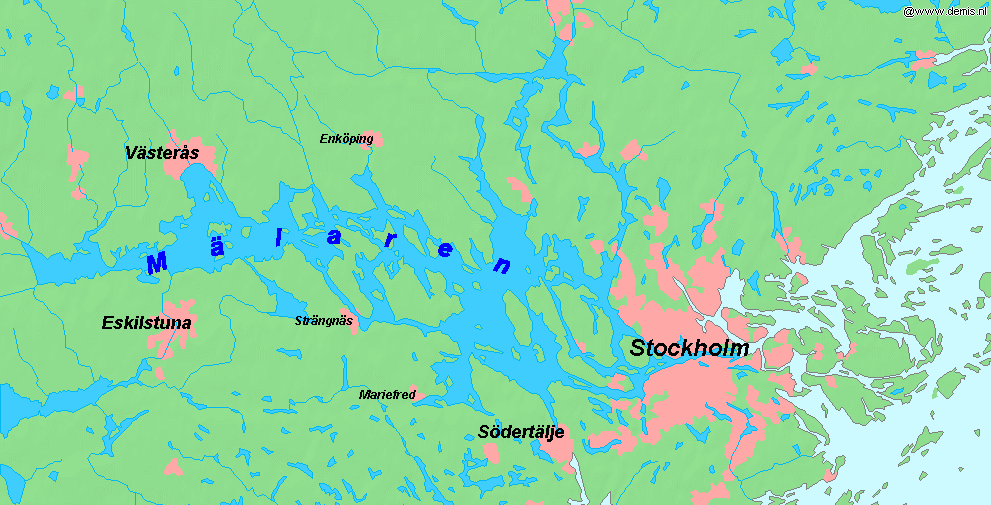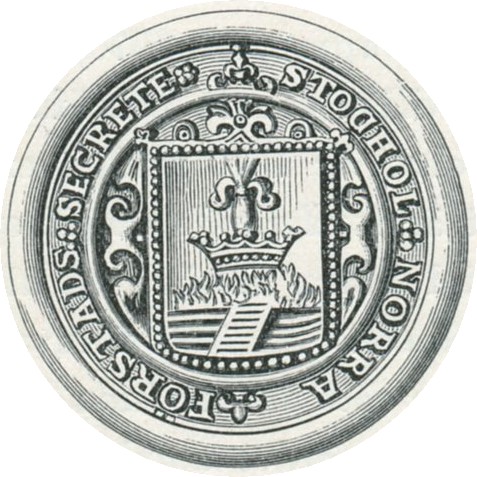|
Järntorget (Stockholm)
is a small public square in Gamla stan, the old town in central Stockholm, Sweden. Located in the southernmost corner of the old town, the square connects the thoroughfares Västerlånggatan and Österlånggatan, while the two alleys, Södra Bankogränd and Norra Bankogränd, stretches east to connect the square to Skeppsbron, and two other alleys, Järntorgsgatan and Triewaldsgränd, leads south to Slussplan and Kornhamnstorg respectively. The second oldest square in Stockholm, slightly younger than Stortorget, Järntorget dates back to around 1300 and remained the city's most important trade centre for centuries — constantly busy and crowded, scents and noise intermixing while goods were transported from shore to shore across the square and up and down the attics of the surrounding buildings. History Prehistory The island is part of the post glacial boulder ridge Brunkebergsåsen stretching north to south through central Stockholm forming an elongated hil ... [...More Info...] [...Related Items...] OR: [Wikipedia] [Google] [Baidu] |
Järntorget 2009
Järntorget (Swedish language, Swedish: "Iron Square") is a common name for public squares in Sweden, Swedish cities, the two most well-known being: * Järntorget (Stockholm) * Järntorget (Göteborg) {{geodis ... [...More Info...] [...Related Items...] OR: [Wikipedia] [Google] [Baidu] |
Stortorget (Stockholm)
Stortorget (, "the Grand Square") is a public square in Gamla Stan, the old town in central Stockholm, Sweden. It is the oldest square in Stockholm, the historical centre on which the medieval urban conglomeration gradually came into being. Today, the square is frequented by tens of thousands of tourists annually, and is occasionally the scene for demonstrations and performances. It is traditionally renowned for its annual Christmas market offering traditional handicrafts and food. Notable buildings and structures Located in the centre of the plateau of Stadsholmen, the square never was the stylish show-piece occupying the centre of many other European cities during the Middle Ages; it was created gradually, buildings and blocks around the square, still sloping west, occasionally added haphazardly. The exception being the Stock Exchange Building taking up the northern side of the square and concealing the Cathedral and the Royal Palace. The Stock Exchange Building and th ... [...More Info...] [...Related Items...] OR: [Wikipedia] [Google] [Baidu] |
Södermalm
Södermalm, often shortened to just Söder, is the southern district of Stockholm City Centre. Overview The Södermalm district covers the island of the same name (formerly called ''Åsön''), which, however, is not fully separated from the peninsula of Södertörn (or the rest of the Swedish mainland), as water to both its north and south does not flow freely but passes through a Karl Johansslussen, lock and a Hammarbyleden, man-made waterway. Södermalm is connected to its surrounding areas by a number of bridges. It connects to Gamla stan to the north by Slussenområdet, Slussen, a grid of road and rail and a lock separating the lake Mälaren from the Baltic Sea, to Långholmen to the northwest by one of the city's larger bridges, Västerbron, to the islet Reimersholme to the west, to Liljeholmen to the southwest by the bridge Liljeholmsbron, to Årsta by Årstabroarna, Årstabron and Skansbron, to Johanneshov by Johanneshovsbron and Skanstullsbron to the south, and, fin ... [...More Info...] [...Related Items...] OR: [Wikipedia] [Google] [Baidu] |
Three Crowns
Three Crowns () is the national emblem of Sweden, present in the coat of arms of Sweden, and composed of three yellow or Gilding, gilded coronets ordered two above and one below, placed on a blue background. Similar designs are found on a number of other coats of arms or flags. The emblem is often used as a symbol of official State authority by the Monarchy of Sweden, Monarchy, the Riksdag, the Government, Government of Sweden and by List of diplomatic missions of Sweden, Swedish embassies around the world, but also appears in other less formal contexts, such as the Sweden men's national ice hockey team, who wear the symbol on their hockey jersey, sweaters and hence are called "Three Crowns", and atop the Stockholm City Hall (built 1911–1923). The Three Crowns are also used as the roundel on military aircraft of the Swedish Air Force and as a sign on Swedish military equipment in general, and also on the uniforms and vehicles of the Swedish Police Authority. Origins Use ... [...More Info...] [...Related Items...] OR: [Wikipedia] [Google] [Baidu] |
Griffin
The griffin, griffon, or gryphon (; Classical Latin: ''gryps'' or ''grypus''; Late and Medieval Latin: ''gryphes'', ''grypho'' etc.; Old French: ''griffon'') is a -4; we might wonder whether there's a point at which it's appropriate to talk of the beginnings of French, that is, when it wa ...: ''griffon'') is a legendary creature with the body, tail, and Hindlimb">back legs of a lion, and the head and wings of an eagle">lion.html" ;"title="Hindlimb">back legs of a lion">Hindlimb">back legs of a lion, and the head and wings of an eagle with its talons on the front legs. Overview Because the lion was traditionally considered the king of the beasts and the eagle the king of the birds, by the Middle Ages, the griffin was thought to be an especially powerful and majestic creature. Since classical antiquity, griffins were known for guarding treasures and priceless possessions. In Greek and Roman texts, griffins and Arimaspians were associated with gold deposits of Central Asia. ... [...More Info...] [...Related Items...] OR: [Wikipedia] [Google] [Baidu] |
Suecia 1-054 ; Sodra Bancohuset
In Modern English, the name of Sweden ( ) is derived from 17th century Middle Dutch and Middle Low German. In Old English, the country was named ''Swēoland'' (literally "Swede land") and ''Swēorīċe'' (literally "Swede kingdom"); the latter is cognate with Old Norse ''Svíaríki''. Anglo-Norman of the 12th and 13th centuries used ''Suane'' and ''Swane'' (with the adjective as ''Suaneis''). In Scots, ''Swane'' and ''Swaine'' appear in the 16th century. Early Modern English used ''Swedeland''. The Old English name for Sweden was ''Swēoland'' or ''Swēorīċe'', land or kingdom of the ''Swēon'', whereas the Germanic tribe of the ''Swedes'' was called ''Svíþjóð'' in Old Norse. The latter is a compositum consisting of ''Sví'' which means Swedish and ''þjóð'' which means people. The word ''þjóð'' has its origin in the elder Indo-European word ''teuteh''. The name of the ''Sviar'' is derived from a self-designation containing the Germanic reflexive '' *s(w)e'' "one's own ... [...More Info...] [...Related Items...] OR: [Wikipedia] [Google] [Baidu] |
Train Oil
Whale oil is oil obtained from the blubber of whales. Oil from the bowhead whale was sometimes known as train-oil, which comes from the Dutch word ''traan'' ("tear drop"). Sperm oil, a special kind of oil used in the cavities of sperm whales, differs chemically from ordinary whale oil: it is composed mostly of liquid wax. Its properties and applications differ from those of detergentized whale oil, and it was sold for a higher price. Source and use Emerging industrial societies used whale oil in oil lamps and to make soap. In the 20th century it was made into margarine. There is a misconception that commercial development of the petroleum industry and vegetable oils saved whales from extinction. In fact, the development of petroleum accelerated the whaling industry, which peaked in the 1960s. In the 21st century, with most countries having banned whaling, the sale and use of whale oil has practically ceased. Whale oil was obtained by boiling strips of blubber harvested from ... [...More Info...] [...Related Items...] OR: [Wikipedia] [Google] [Baidu] |
Järntorget Våghuset Svartbrödraklotret Vädersolstavlan
{{geodis ...
Järntorget ( Swedish: "Iron Square") is a common name for public squares in Swedish cities, the two most well-known being: * Järntorget (Stockholm) * Järntorget (Göteborg) Järntorget ( Swedish: "Iron Square") is a common name for public square A town square (or public square, urban square, city square or simply square), also called a plaza or piazza, is an open public space commonly found in the heart of a tr ... [...More Info...] [...Related Items...] OR: [Wikipedia] [Google] [Baidu] |
Baltic Sea
The Baltic Sea is an arm of the Atlantic Ocean that is enclosed by the countries of Denmark, Estonia, Finland, Germany, Latvia, Lithuania, Poland, Russia, Sweden, and the North European Plain, North and Central European Plain regions. It is the world's largest brackish water basin. The sea stretches from 53°N to 66°N latitude and from 10°E to 30°E longitude. It is a Continental shelf#Shelf seas, shelf sea and marginal sea of the Atlantic with limited water exchange between the two, making it an inland sea. The Baltic Sea drains through the Danish straits into the Kattegat by way of the Øresund, Great Belt and Little Belt. It includes the Gulf of Bothnia (divided into the Bothnian Bay and the Bothnian Sea), the Gulf of Finland, the Gulf of Riga and the Bay of Gdańsk. The "Baltic Proper" is bordered on its northern edge, at latitude 60°N, by Åland and the Gulf of Bothnia, on its northeastern edge by the Gulf of Finland, on its eastern edge by the Gulf of Riga, and in the ... [...More Info...] [...Related Items...] OR: [Wikipedia] [Google] [Baidu] |
City Wall
A defensive wall is a fortification usually used to protect a city, town or other settlement from potential aggressors. The walls can range from simple palisades or Earthworks (military), earthworks to extensive military fortifications such as curtain wall (fortification), curtain walls with Fortified tower, towers, bastions and gates for access to the city. From ancient to modern times, they were used to enclose settlements. Generally, these are referred to as city walls or town walls, although there were also walls, such as the Great Wall of China, Walls of Benin, Hadrian's Wall, Anastasian Wall, and the Atlantic Wall, which extended far beyond the borders of a city and were used to enclose regions or mark territorial boundaries. In mountainous terrain, defensive walls such as ''letzis'' were used in combination with castles to seal valleys from potential attack. Beyond their defensive utility, many walls also had important symbolic functions representing the status and indepen ... [...More Info...] [...Related Items...] OR: [Wikipedia] [Google] [Baidu] |
Mälaren
Mälaren ( , , or ), historically referred to as Lake Malar in English, is the third-largest freshwater lake in Sweden (after Vänern and Vättern). Its area is and its greatest depth is 64 m (210 ft). Mälaren spans from east to west. The lake drains, from south-west to north-east, into the Baltic Sea through its natural outlets Norrström and Söderström (as it flows around Stadsholmen island) and through the artificial Södertälje Canal and Hammarbyleden waterway. The easternmost bay of Mälaren, in central Stockholm, is called Riddarfjärden. The lake is located in Svealand and bounded by the provinces of Uppland, Södermanland and Västmanland. The two largest islands in Mälaren are Selaön () and Svartsjölandet (). Mälaren is low-lying and mostly relatively shallow. Being a quite narrow and shallow lake, Mälaren has bridge crossings between Eskilstuna and Västerås with two crossings on the western end at Kvicksund and three separate bridges between St ... [...More Info...] [...Related Items...] OR: [Wikipedia] [Google] [Baidu] |
Norrmalm
Norrmalm is a city district in Stockholm, Sweden. History Norrmalm is a part of the larger borough of Norrmalm (''Norrmalms stadsdelsområde''). The southern part of the district, Lower Norrmalm (''Nedre Norrmalm''), also known as the City, constitutes the most central part of Stockholm, while Upper Norrmalm (''Övre Norrmalm'') is more residential. The name Norrmalm is first mentioned in 1288. In 1602, Norrmalm became an independent city with its own mayor and administration called the Northern Suburb (''Norra Förstaden''). The town was short-lived, and in 1635 it was incorporated with Stockholm again. Norrmalm is today considered to be the central part of Stockholm. Redevelopment of Norrmalm In the 1950s and 1960s, large parts of Lower Norrmalm were torn down to build a new and modern city. The demolitions were carried out swiftly, and many Stockholmers still miss "old Klara" (Klara is a part of Lower Norrmalm). Among the new features created as a result of the clearan ... [...More Info...] [...Related Items...] OR: [Wikipedia] [Google] [Baidu] |





